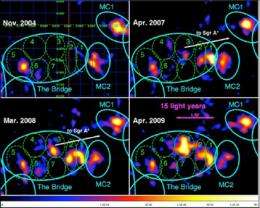The turbulent past of the Milky Way's black hole

The supermassive black hole at the center of our Galaxy went through turbulent times over the past centuries. We know this thanks to its surrounding molecular clouds, whose varying X-ray and gamma-ray luminosity reflects a major flare in the past. These findings, obtained by an international team of researchers led by French astrophysicists, are published in The Astrophysical Journal.
The black holes located in active galactic nuclei usually show intense activity. But this is not true of our own Galaxy's black hole, Sgr A*, which shows very low activity. However, an international team of researchers, led by astrophysicists from the Astroparticle and Cosmology Laboratory in Paris, has succeeded in showing that the black hole was active in the very recent past, and that it is therefore not as unusual as it seemed.
XMM-Newton and INTEGRAL, two ESA satellites to which CNES, CEA and CNRS-INSU have made a major contribution, have enabled researchers to observe X-ray and gamma-ray emissions from molecular clouds in the region of the galactic center, near Sgr A*. The scientists were surprised to discover that the emissions showed spectacular variation, such as the progressive brightening of one of the clouds between 2004 and 2009, at an apparent speed three times greater than that of light (see Fig. 1).
The phenomenon shows that the clouds reflect the high-energy radiation produced by the intense activity of the supermassive black hole. The light echo that reaches us is delayed in comparison with the direct light from the black hole. This delay depends on the position of the cloud and on the time the radiation takes to travel the distance from the black hole to the cloud. By observing the decay of the gamma-ray emission from another cloud (Fig. 2), the researchers estimated the duration and intensity of the flare, which began around four centuries ago and ended at the beginning of the twentieth century. For three hundred years, our Galaxy's supermassive black hole was therefore a million times brighter than now.
More information: ArXiv paper: arxiv.org/abs/1005.4807
Provided by CNRS




















